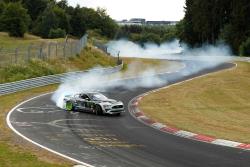
Vaughn Gittin Jr. drifting the Nürburgring | Drifting is not a sport for the faint of heart, and Vaughn Gittin Jr. is anything but. Since 2004—Formula Drift’s inaugural year—he has been a self-proclaimed “professional fun haver”; the rare combination of a fierce competitor with the heart and passion of a dedicated hobbyist. Always watchful for the next big challenge, Gittin Jr. recently completed a world first—drifting the entire north loop at Nürburgring.Built in the 1920s in the Eifel mountains of Germany, the Nürburgring north loop (Nordschleife) is 12.9 miles of demanding turns with over 1,000 feet of elevation change. The former location for the German Grand Prix, the loop has earned the moniker “The Green Hell”. Gittin Jr. became the first driver to drift the entire course—demonstrating both his driving prowess and the power and agility of his Mustang RTR. 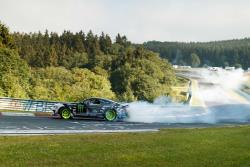
The Mustang RTR reached speeds of 150-mph on the track | Gittin Jr. began competing in Formula Drift in his personal Nissan S13, but quickly captured the attention of Ford Racing, who began a partnership with him in 2009. Ford and Gittin Jr. collaboratively launched the Mustang RTR in 2010. Today, Vaughn races in the Monster Energy Nitto Tire Ford Racing Mustang, which features a 900-horsepower, 9000-rpm engine built by Ford Performance and Roush Yates Engines. 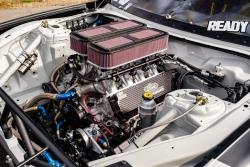
The Mustang RTR features a 100-8578 filter assembly | He has an impressive list of wins—including three World Drift Series Championships (2011, 2012, and 2013), and the title of the only American to win two D1 Grand Prix events. He was honored as the Formula Drift Ace Driver of the Decade in 2013, which recognized his participation in all ten seasons of the series and the most tandem victories of any Formula Drift driver. He also owns RTR Motorsports (for which he races), based in Baltimore, Maryland.Gittin Jr.’s Mustang RTR features a custom K&N® performance filter—which features the same technology as K&N®’s original High-Flow Air Filters, trusted for their ability to provide exceptional engine protection. You can search for one to fit your vehicle here. “I’ve been working with K&N on an official level for fifteen years now,” Gittin Jr. commented. “But prior to that, I ran K&N [products] on my first car that I used to race in industrial parks and parking lots. That started my love for K&N. It’s an honor, fifteen years later, to still be working with them. No matter what I’m doing—whether it is Formula Drift, Ultra4, or just general fun-having—and no matter where in the world I am, K&N Filters are ready to party with me and are my weapons of choice!" You can see Vaughn Gittin Jr. compete in Round 8 of the Formula Drift Pro Series at Irwindale Speedway in Irwindale, California on October 12-13. |
| In the early 1960s, two motorcycle racers—Ken Johnson and Norm McDonald—developed a ground-breaking new idea for an air filter that could perform under the demands of an off-road environment. After experimenting with many different types of filter media, they discovered that an oiled cotton design allowed the filter to not only capture dirt and contaminants very efficiently, but also allowed it to be washed and reused. Just like that, the original High-Flow Air Filter™ was born. To this day, K&N continues to be an industry leader in filtration technology—and engineers each air filter for efficiency, capacity, durability, and airflow. Maintaining the proper air-to-fuel ratioMaintaining the proper air-to-fuel ratio (AFR) is critical for engine performance, and relates to the amount of air versus the amount of fuel used by an engine for combustion. A correct, stoichiometrically balanced AFR produces combustion with perfect efficiency, excluding other factors. For gasoline engines, the theoretically perfect chemical ratio is 14.7:1—14.7 parts air to one part fuel. In effect, this means that an engine requires almost fifteen times more air than fuel for efficient combustion—which emphasizes the importance of providing a high volume of air through an air filter. How do engines produce power?An internal combustion engine operates by burning a mixture of fuel and oxygen within the engine’s cylinders. A spark plug ignites the volatile gas, creating an explosion that forces the piston downward—turning the crankshaft. The piston-moving force that’s created during the combustion cycle is what produces horsepower. Why not use a disposable paper air filter? 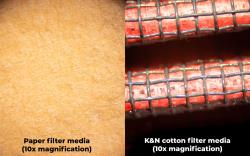
Typical paper filters can be very restrictive to airflow—note the lack of openings in the media | Typical disposable paper air filters function on a size-dependent basis—dirt particles that are larger than the openings in the filter media are blocked, while particles that are smaller than the openings can pass through. Most disposable paper filters create airflow restriction, as the openings in the filter media have to be tiny in order to filter efficiently—which can slow down airflow. Because dust accumulates on the surface of the disposable filter and can block passageways for airflow, the filter’s performance typically decreases consistently throughout its service interval.The four major elements of filtrationK&N designs every K&N filter to balance the four most critical elements of filtration: efficiency, capacity, durability, and airflow. Under normal circumstances, most automotive air filters demonstrate an inverse relationship between airflow and efficiency—the higher the airflow, the less efficient the air filter is at protecting the engine, and vice versa. Many filter companies claim that their filters capture 99% of contaminants (or more), but there’s a trade-off, as most filters designed to block almost all contaminants are likely to also block the majority of airflow—stifling your engine’s oxygen supply. A standard disposable paper filter exhibits a principle called surface loading—dust collects only on the surface of the media, which can provide a high level of contaminant capture/efficiency (the filter is mostly impermeable, which keeps dirt and contaminants from passing through to the engine) but a low level of airflow, reducing engine performance. 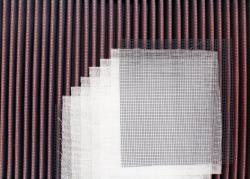
High-Flow Air Filters™ typically feature four or six layers of oiled cotton fabric | In contrast, K&N High-Flow Air Filters™ utilize depth loading, in which multiple layers of pleated cotton fibers provide particle retention on many levels. However, while most typical paper or foam filters would experience an unacceptable reduction in airflow with a dramatic increase in efficiency, High-Flow Air Filters™ are specifically engineered to capture dirt while still allowing a high volume of airflow to pass through. As a result, High-Flow Air Filters™ are able to capture contaminants (efficiency), hold a large volume of dirt (capacity), and still provide an outstandingly high volume of air to the engine (airflow). In addition, High-Flow Air Filters™ are designed to last for the entire lifespan of a vehicle (durability). If I can see light through my air filter, does that mean that dirt is getting through too? 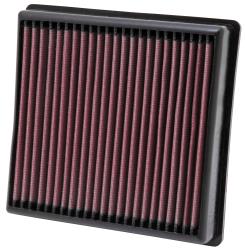
High-Flow Air Filters™ feature a pleated, oiled cotton media | Some consumers have expressed concern that when holding a K&N High-Flow Air Filter™ up to a light source, there are holes/passageways visible in the filter media. If High-Flow Air Filters™ operated solely on a size-dependent basis like a typical disposable air filter, this would be a valid concern—the assumption being that any particles smaller than the passageways would flow through to the engine—but High-Flow Air Filters™ are designed to utilize the principle of diffusion to increase the capture of engine contaminants. Extremely small particles are typically highly affected by forces within the flow of air, including changes in pressure, velocity, or turbulence—and these factors often make their behavior chaotic. While this erratic behavior might sound detrimental to filtration, it can actually be an advantage, as the smallest particles typically do not follow the main flow of air through the passageways in the filter; instead, their chaotic motion causes them to collide with microscopic fibers inside the filter media, where they are then trapped and held by the filter oil. In the media of a typical disposable paper filter, any particles that are smaller than the openings in the media will likely pass right through—but the tacky, sticky nature of K&N filter oil and the multi-layer media design of High-Flow Air Filters™ help capture contaminant particles that are much smaller than the openings/passageways within the filtration media. 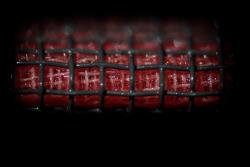
Oiled fibers in the filter media of High-Flow Air Filters™ shown at 10x magnification | Can a K&N oiled air filter cause a mass airflow sensor to fail?An unsubstantiated claim has circulated for many years saying that K&N oiled air filters can cause mass airflow sensors to fail. K&N has thoroughly investigated this claim, and has found no evidence to suggest that K&N filter oil is able to cause MAF sensor damage. In fact, over the past several years, K&N has compiled data regarding MAF sensors sent in by consumers and dealerships, which you can view here: MAF Sensor Test Results. In most cases, the MAF sensors were actually working as they should—which would be a perplexing result, if not for the fact that most dealerships are unable to test MAF sensors. K&N has yet to encounter a dealership with the test equipment necessary to determine whether or not an MAF sensor is functioning properly, which frequently leads to misdiagnosis. For this reason, in almost all cases, the diagnosis of a faulty MAF sensor is merely an educated—or sometimes uneducated—guess. However, in response to consumer concerns, K&N performed extensive testing to determine whether or not filter oil could cause an MAF sensor to fail—going so far as to completely coat an MAF sensor in filter oil—and was not able to create a scenario in which the MAF sensor was damaged by the oil (you can view the procedure and results here: MAF Testing Results and Findings). In K&N’s study, of 437 sensors tested, 298 of them were actually functioning properly (68.19%)—indicating that misdiagnosis of MAF sensors is a frequent issue. Of the sensors that were truly malfunctioning, approximately 33% demonstrated complete electronic failure, with 67% experiencing electrical variance. Of the latter category, over 36% were found to be manufacturer-contaminated with silicone. K&N filter oil was not found to be responsible for any of the sensor malfunctions. DRYFLOW® non-oiled filter media 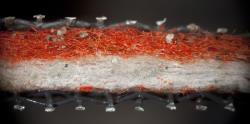
Dryflow® air filter feature lofted media (the red portion of the image) | While the oiled High-Flow Air Filter™ continues to be the most popular filter type among K&N products, K&N also offers non-oiled synthetic Dryflow® air filters. The Dryflow® filter media is composed of lofted synthetic material, which—much like High-Flow Air Filter™ media—provides depth loading properties. However, since Dryflow® filters do not feature the K&N filter oil that is designed to trap and hold particles, the Dryflow® filter media is more restrictive to airflow than High-Flow Air Filter™ media—though it is still designed to strike a desirable balance between airflow and efficiency, provide a high level of contaminant capture, and outperform typical disposable paper air filters in airflow. Because they do not have to be re-oiled, servicing Dryflow® air filters is typically a quick and easy process. K&N filter media types are designed for performanceK&N engineers each filter media type to provide performance for specific applications—for example, heavy diesel and outdoor power High-Flow Air Filters™ are designed with six layers of cotton that feature a particularly fine weave, which can provide an additional level of protection in demanding driving conditions. Synthetic, non-oiled Dryflow® filter media is incorporated into many heavy duty diesel filters, and a large, conical Dryflow® air filter is included with Blackhawk Induction™ intake systems. Many applications will have multiple filter options available, allowing you to select the filter type that fits your needs and preferences. If you have questions regarding filter types, please feel free to contact K&N’s customer service. Join the millions of customers who trust K&N to provide performance and protection products for their vehicles. Visit the application search page to explore air filter options for your specific vehicle. |
|
Designed to add performance to 2016-2018 Chevrolet Malibu 1.5L models, the 63-3106 K&N® performance air intake system offers a guaranteed increase in horsepower and torque for Chevy Malibus—and features a washable, reusable High-Flow Air Filter™ to help protect against contaminants that can damage your engine. A specifically designed steel heat shield helps protect the air filter from high engine temperatures, which in turn can increase engine combustion efficiency. 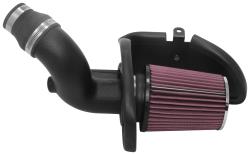
The 63-3106 has a steel heat shield to help protect the filter from hot engine bay temperatures | The 2018 Chevrolet Malibu offers a user-friendly infotainment system, excellent gas mileage, and a spacious interior—with a brand-new 360-degree camera now available. The 2017 Malibu was named an IIHS Top Safety Pick, and the 2018 model has received an NHTSA 5-Star Overall vehicle score.K&N PERFORMANCE AIR INTAKE SYSTEMS BOOST HORSEPOWER 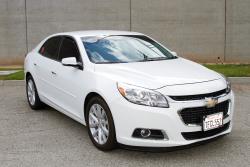
The 2016 Chevrolet Malibu | To give your Malibu an extra boost in power, check out the 63-3106 performance air intake system—specifically engineered for 2016-2018 Chevy Malibus. The 63-3106 is designed to keep air moving through the system cooler, which in turn can increase the efficiency of your engine. The 63-3106 is engineered to provide a less restrictive path for airflow; many factory intake systems include components that can obstruct airflow, and obstructions often create turbulence which products heat. Under typical circumstances, the hotter the air that reaches the engine, the less efficient engine combustion will be. By providing a smoother path for airflow, the 63-3106 helps produce more efficient combustion—giving you a boost in horsepower. AERODYNAMIC INTAKE TUBE INCREASES AIRFLOWTypical factory air intake systems force air through a restrictive disposable paper air filter before the air travels through a complex system of tubing. Multiple turns, bends, and baffles can significantly slow the flow of air to the engine. The 63-3106 intake system features a free-flowing, high-density polyethylene (HDPE) intake tube, which is engineered to reduce turbulence in the air, keeping engine air cooler—and increasing engine performance! A radius adapter allows the filter to mount directly to the intake tube, which reduces hardware and helps increase ease of installation. HIGH-FLOW AIR FILTER™ OFFERS EXCEPTIONAL PROTECTION 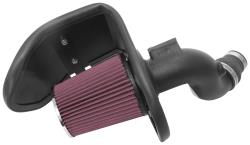
The 63-3106 for 2016-2018 Chevrolet Malibus features a High-Flow Air Filter™ | To help ensure engine performance, it’s extremely important to balance the four critical elements of filtration—efficiency, capacity, durability, and airflow. K&N’s game-changing filter design—the K&N High-Flow™ Air Filter—is designed to provide high airflow rates while offering outstanding engine protection from dust, dirt, and other harmful airborne contaminants. The filter’s innovative design of oiled, layered cotton media is washable, reusable, and durable—engineered to last for the entire lifespan of a vehicle, and backed by K&N®’s reputation for industry-leading quality. The High-Flow Air Filter™ included in the 63-3106 intake kit is oversized, providing a large amount of surface area and allowing for a service interval of up to 100,000 miles between cleanings (under normal highway driving conditions). When your filter does need to be cleaned, you can use the K&N Recharger® Kit (99-5000 or 99-5050) to quickly and easily restore your filter’s performance. Each K&N intake (and filter!) is designed to last for the life of your vehicle. HEAT SHIELD HELPS PROTECT INTAKE AIR AND FILTERThe 63-3106 features a steel heat shield which helps protect the air filter—and filtered air—from the high temperatures of the engine bay. Since cold air is denser with oxygen molecules than hot air, keeping airflow cooler can help increase engine combustion efficiency. 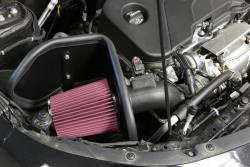
K&N air intake systems come with a 10-Year/Million Mile Limited Warranty | INSTALLATIONThe K&N 63-3106 intake system is engineered to incorporate factory mounting points and the factory mass air sensor. Installation can typically be completed in 90 minutes or less, and requires only basic hand tools. Detailed instructions are included in your kit, and installation videos for many vehicles are available on the K&N website. Engineered to fit: • 2016 Chevrolet Malibu 1.5L L4 Fuel Injection All Models • 2017 Chevrolet Malibu 1.5L L4 Fuel Injection All Models • 2018 Chevrolet Malibu 1.5L L4 Fuel Injection All Models WARRANTYEach intake system comes with a 10-Year/Million Mile Limited Warranty. Installing a K&N replacement air intake system will not void your factory warranty; in the U.S., manufacturers must provide evidence that an aftermarket part is the cause of a necessary repair in order to void or deny warranty coverage. The Consumer Products Warranty Act of 1975 (also known as the Magnuson-Moss Warranty Act) protects consumers’ rights to their warranty coverage. DYNAMOMETER RESULTSK&N performance air intake systems come with an industry-leading guarantee—you‘ll get an increase in horsepower and torque! During dynamometer testing, a 2016 Chevrolet Malibu 1.5L with a factory air intake system was recorded at 131.9-horsepower at 5491 RPM. After installation of 63-3106, the same vehicle was recorded at 140.4-horsepower at 5491 RPM—an estimated increase of 8.5-horsepower. The torque also jumped from 120.0 lb.-ft. to 124.5 lb.-ft.—an estimated increase of 4.5 lb.-ft. at 3156 RPM. Horsepower gains vary among products and applications, but each K&N performance air intake system is designed to increase airflow efficiency for specific vehicles and their engines. Each kit undergoes significant testing to help ensure that the filter and intake tube are engineered to deliver large increases in airflow and horsepower. Please visit individual product pages to view horsepower estimates for your specific vehicle. Visit this page to purchase the 63-3106 air intake system, or visit the vehicle application search to explore air intake system options for your vehicle. Join the millions of customers who trust K&N to help them boost performance and protection in their vehicles!* This air intake cannot be sold in California. It is not legal for use in California or other states adopting California emission standards. Not legal for highway use in states adopting California emission regulations. |
| It was an emotional weekend for Florida resident Brian Forrester, who attended his 50th consecutive NHRA U.S. Nationals at Indianapolis. He has been attending every year since 1969, when he was only four years old. 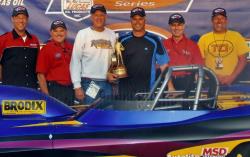
Larry and Brian (center) following Brian’s win in Super Gas in 2009 | Brian’s father, Larry Forrester, began the tradition of attending Indy every year after he realized how much Brian loved to watch racing. “He sat there for three straight days—we would only leave our seats to go to the bathroom,” Larry commented. “He was mesmerized by it. When I told him it was over and time to go home, he actually cried and said he wasn’t ready.”And just like that, a tradition was born. The Forrester family began attending Indy over Labor Day weekend every year, and did so for many years together. In 1977, Larry decided he was interested in racing himself, and began competing in bracket racing in Illinois. Due to his father's racing schedule, Brian's mother, Nancy, took him to Indy that year. "For her to take me that year was really cool," he said. "I would have never been able to make it to 50 if she hadn't done that for me." Brian also got the racing bug—going so far as to write in his high school yearbook that his dream was to win the nationals one day at Indianapolis. He began racing in the NHRA Super Gas category in 1989. From that year until 2010, Brian attended Indy every year as a competitor. Brian earned a Super Gas national championship in 2008, and in 2009—after having been to the finals twice, once in Super Gas and once in Super Comp—Brian finally achieved his dream of winning at Indy in the Super Gas category. It was the win he had dreamed about since he was a child, and his father was there—cheering him on, just as he always had. Brian’s mother, Nancy, wasn’t able to attend—but surprised him by arranging for a limo to take him to the awards banquet. “She was so proud of Brian,” Larry said. “She cried for days, she was so happy for him.” After finally achieving his dream, Brian decided to retire from racing in order to spend more time with his family—his wife, Robin, and their two children. “I give him credit for that,” Larry said, in reference to Brian’s choice to leave the sport. Brian continued working in the racing industry for some time, building racecars, before transitioning into a career at an automobile repair company. Still, without fail, he returned to Indy over Labor Day weekend each year. 
Larry and Brian Forrester at Indianapolis Motor Speedway | Nancy, Brian’s mother, passed away in 2014 after a long battle with breast cancer. “A friend told me that she thought Nancy would be very proud of us,” Larry commented, “And that she would be so happy to see us attending this milestone event together. We couldn’t have done it without her.”And so, this past weekend was a watershed moment for both Larry and Brian—a landmark half a century in the making. “We definitely took advantage of every minute we were there,” commented Brian. “It was a wonderful weekend…it brought back so many memories,” added Larry. “I was very moved. I feel so blessed to have been able to do that with Brian, because we’ve spent so much time together. He’s my best friend. To share that experience with my son has been one of the highlights of my life.” |
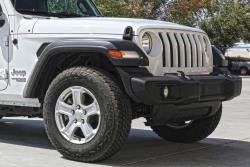
K&N air intake systems come with a 10-Year/Million Mile Limited Warranty | Engineered for 2018 Jeep Wrangler JL 3.6L V6 models, the 63-1576 K&N® performance air intake system offers a guaranteed increase in horsepower and torque for Jeep Wranglers—and features a washable, reusable High-Flow Air Filter™ to help protect against damaging engine contaminants. In addition, the enclosed air box is designed to provide additional protection during challenging off-road adventures—and can help protect your filter during water crossings. The 2018 Jeep Wrangler JL has been fully redesigned—and it shows. With nearly unbeatable off-road capability for its class and advanced tech features, the new Wrangler is engineered to help you tackle your adventures off the beaten path with ease. K&N PERFORMANCE AIR INTAKE SYSTEMS BOOST HORSEPOWERIf you want to give your Wrangler a little extra “oomph”, check out the 63-1576 performance air intake system—specifically designed to fit in the engine bay of 2018 Wrangler JLs. The 63-1576 is designed to keep engine air cooler (which can increase engine combustion efficiency), and provides a smooth, low-restriction path for airflow to the engine. Many stock intake systems have airflow-obstructing components that can create turbulence—and thus heat—resulting in less efficient combustion, and giving you less horsepower. By replacing the complete factory system with an aerodynamic tube and High-Flow Air Filter™, your engine will have access to a higher volume of cool air—giving you a guaranteed increase in horsepower and torque. AERODYNAMIC INTAKE TUBE INCREASES AIRFLOWTypical factory air intake systems force air through a restrictive disposable paper air filter before the air travels through a complex system of tubing—which often has tight bends, baffles, and other elements that can cause swirling, turbulent air. Excess turbulence can cause the molecules within the air to collide, which creates heat—and an increase in temperature reduces the density of oxygen molecules in the air. Since engine combustion is most efficient in an oxygen-rich environment, keeping engine air cooler often significantly increases engine combustion efficiency. 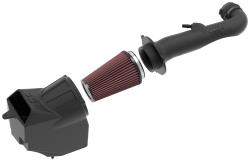
The 63-1576 for the 2018 Jeep Wrangler JL features a High-Flow Air Filter™ | The 63-1576 intake system features a free-flowing, high-density polyethylene intake tube, which is engineered to reduce turbulence in the air, keeping engine air cooler—and increasing engine performance! An incorporated radius adapter allows the filter to mount directly to the intake tube, which reduces hardware and helps increase ease of installation.HIGH-FLOW AIR FILTER™ OFFERS EXCEPTIONAL PROTECTIONMost factory disposable paper filters only “surface load” contaminants—collecting them on the surface of the media, which over time can reduce the filter’s efficiency due to clogging. Alternatively, High-Flow Air Filters™ “depth load” contaminants; multiple layers of cotton fibers capture particles on many levels. Because the contaminants are incorporated into the filter fibers, the filter can still operate without significantly reducing its efficiency. Additionally, the layered, pleated design of the filter media increases the surface area of the filter—providing significantly more contaminant capture per square inch of media over a standard paper filter. The High-Flow Air Filter™ included in the 63-1576 intake kit is oversized (625 square inches of media) with a conical shape, providing a greater surface area and allowing for a service interval of up to 100,000 miles between cleanings (under normal highway driving conditions). High-Flow Air Filters™ feature an oiled, layered design—providing up to 50% more airflow over a disposable filter. When your filter does need to be cleaned, you can use the K&N Recharger® Kit (99-5000 or 99-5050) to quickly and easily restore your filter’s performance. Each K&N intake (and filter!) is designed to last for the life of your vehicle. AIR BOX HELPS PROTECT INTAKE AIR AND FILTERThe 63-1576 features a high-density rotationally-molded polyethylene air box, which helps protect the air filter and intake air from high engine temperatures and directs airflow into the throttle body. The enclosed air box design helps create a barrier against dust, dirt, and moisture—all of which can be present in rigorous off-road environments—and is designed to provide additional filter protection during water crossings. INSTALLATION 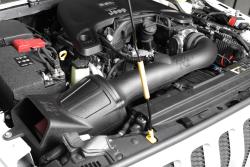
The 63-1576 air intake system after installation | The K&N 63-1576 intake system is engineered to incorporate factory mounting points and the factory mass air sensor. Installation can typically be completed in 90 minutes or less, and requires only simple hand tools. Detailed instructions are included in your kit, and installation videos for many vehicles are available on the K&N website.Engineered to fit: 2018 Jeep Wrangler JL 3.6L V6 Fuel Injection All Models WARRANTYEach intake system comes with a 10-Year/Million Mile Limited Warranty. Furthermore, using a K&N replacement air intake system will not void your factory warranty; in the U.S., manufacturers must provide evidence that an aftermarket part is the cause of a necessary repair in order to void or deny warranty coverage. The Consumer Products Warranty Act of 1975 (also known as the Magnuson-Moss Warranty Act) protects consumers’ rights to their warranty coverage. 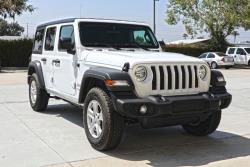
The 2018 Jeep Wrangler JL is engineered for excellent off-road performance | DYNAMOMETER RESULTSK&N performance air intake systems come with a horsepower guarantee—you will get an increase in horsepower and torque! During dynamometer testing, a 2018 Jeep Wrangler JL 3.6L V6 with a factory air intake system was recorded at 178.3-horsepower at 4630 RPM. After installation of 63-1576, the same vehicle was recorded at 190.8-horsepower at 4630 RPM—an estimated increase of 12.5-horsepower. The torque also jumped from 201.4 lb.-ft. to 213.7 lb.-ft.—an estimated increase of 12.2 lb.-ft at 4245 RPM, along with an estimated 56% more airflow compared to the stock intake system. Horsepower gains vary among products and applications, but each K&N performance air intake system is designed to increase airflow efficiency for specific vehicles and their engines. Each kit undergoes significant testing to help ensure that the filter and intake tube are engineered to deliver large increases in airflow and horsepower. Please visit individual product pages to view horsepower estimates for your specific vehicle. Visit this page to purchase the 63-1576 air intake system, or visit the application search page to explore air intake system options for your vehicle. Join the millions of customers who trust K&N to help them boost performance and protection in their vehicles!*Some intake systems are not legal for sale or use on any pollution controlled motor vehicle in California or states adopting California emission procedures. See knfilters.com for CARB status on each part for a specific vehicle.
| | |



























